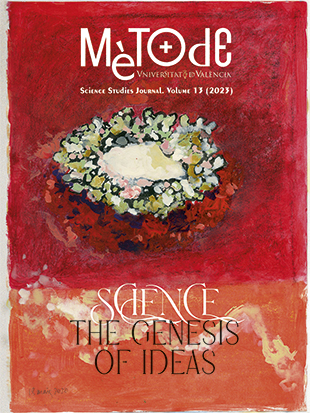La vida adaptada a la precariedad: Ecología de las zonas áridas
DOI:
https://doi.org/10.7203/metode.13.22006Palabras clave:
aridez, sequías, biodiversidad, adaptaciones, desertificación Resumen
Resumen
Las zonas áridas de la Tierra ocupan aproximadamente el 40 % de la superficie terrestre. Su peculiar régimen hidrológico, que sitúa al agua como el principal factor limitante, junto con otras señas de identidad propias, como la variabilidad de las precipitaciones y su heterogeneidad ecológica, convierten a estas regiones en uno de los principales y más relevantes conjuntos de biomas del planeta. Más allá de su estereotipada concepción como lugares de bajo perfil económico y ecológico, estos territorios tienen una biodiversidad enorme y dan sustento al 40 % de la población mundial. El calentamiento global hace que la aridez atmosférica aumente y que las estrategias que durante milenios han desarrollado sus habitantes sean un modelo del que sacar enseñanzas. Conservar estos lugares es esencial para luchar contra el cambio climático y para ello es imprescindible conocer en profundidad su estructura y funcionamiento.
 Descargas
Descargas
 Citas
Citas
Cherlet, M., Hutchinson, C., Reynolds, J., Hill, J., Sommer, S., & von Maltitz, G. (Eds.). (2018). World Atlas of Desertification. Publication Office of the European Union. https://doi.org/10.2760/9205
D’Odorico, P., Bhattachan, A., Davis, K., Ravi, S., & Runyan, C. (2013). Global desertification: Drivers and feedbacks. Advances in Water Resources, 51, 326–344. https://doi.org/10.1016/j.advwatres.2012.01.013
FAO. (2011). Highlands and drylands. (N. Berrahmouni, R. Romeo, D. McGuire, S. Zelaya, D. Maselli, & T. Kohler, Eds.). Food and Agriculture Organization of the United Nations.
FAO. (2019). Trees, forests and land use in drylands: The first global assessment. Food and Agriculture Organization of the United Nations. https://www.fao.org/3/ca7148en/ca7148en.pdf
FAO. (2021). The state of the world’s land and water resources for food and agriculture. Systems at breaking point. Synthesis report. Food and Agriculture Organization of the United Nations. https://doi.org/10.4060/cb7654en
Hewitt, K. (1997). Regions at risk. A geographical introduction to disasters. England. Longman.
Le Houérou, H. N. (1984). Rain use efficiency: A unifying concept in arid-land ecology. Journal of Arid Environments, 7, 213–47.
Lucatello, S., & Huber-Sannwald, E. (2020). Sustainable Development Goals and drylands: Addressing the interconnection. In S. Lucatello, E. Huber-Sannwald, I. Espejel, & N. Martinez-Taguena (Eds.), Stewardship of future drylands and climate change in the Global South (pp. 27–40). Springer.
Maestre, F. T. (2012). Plant species richness and ecosystem multifunctionality in global drylands. Science, 214, 214–218. https://doi.org/10.1126/science.1215442
Maestre, F. T., Benito, B. M., Berdugo, M., Concostrina-Zubiri, L., Delgado-Baquerizo, M., Eldridge, D. J., Guirado, E., Gross, N., Kefi, S., Le Bagousse-Pinguet, Y., Ochoa-Hueso, R., & Soliveres, S. (2021). Biogeography of global drylands. New Phytologist, 231(2), 540–558. https://doi.org/10.1111/nph.17395
Maestre, F. T., Salguero-Gomez, R., & Quero, J. L. (2012). It is getting hotter in here: Determining and projecting the impacts of global environmental change on drylands. Philosophical Transactions of the Royal Society B: Biological Sciences, 367(1606), 3062–3075. https://doi.org/10.1098/rstb.2011.0323
Martinez-Valderrama, J. (2016). Los desiertos y la desertificación. Ediciones Catarata.
Millenium Ecosystem Assessment (MEA). (2005). Drylands. In R. Hassan, R. Scholes, & N. Ash (Eds.), Ecosystems and human well being: Scenarios (pp. 623–662). Island Press.
Mirzabaev, A., Wu, J., Evans, J., Garcia-Oliva, F., Hussein, I. A. G., Iqbal, M. M., Kimutai, J., Knowles, T., Meza, F., Nedjraoui, D., Tena, F., Turkeş, M., Vazquez, R. J., & Weltz, M. (2019). Desertification. In J. M. P. R. Shukla, J. Skea, E. Calvo Buendia, V. Masson-Delmotte, H.-O. Portner, D. C. Roberts, P. Zhai, R. Slade, S. Connors, R. van Diemen, M. Ferrat, E. Haughey, S. Luz, S. Neogi, M. Pathak, J. Petzold, J. Portugal Pereira, P. Vyas, E. Huntley, ... J. Malley (Eds.), Climate change and land: An IPCC special report on climate change, desertification, land degradation, sustainable land management, food security, and greenhouse gas fluxes in terrestrial ecosystems (pp. 249–343). UNEP. https://www.ipcc.ch/srccl/chapter/chapter-3/
Plaza, C., Zaccone, C., Sawicka, K., Mendez, A. M., Tarquis, A., Gasco, G., Heuvelink, G. B., Schuur, E. A. G., & Maestre, F. T. (2018). Soil resources and element stocks in drylands to face global issues. Scientific Reports, 8(1), 1–8. https://doi.org/10.1038/s41598-018-32229-0
Reynolds, J. F., Kemp, P. R., Ogle, K., & Fernandez, R. J. (2004). Modifying the –pulse-reserve– paradigm for deserts of North America: Precipitation pulses, soil water, and plant responses. Oecologia, 141, 194–210. https://doi.org/10.1007/s00442-004-1524-4
UN. (2015, 25 September). General Assembly Resolution 70/1, Transforming Our World: The 2030 Agenda for Sustainable Development, A/RES/70/1. http://undocs.org/A/RES/70/1
UNCCD. (2017). The global land outlook (1st ed.). United Nations Convention to Combat Desertification.
UNEP-WCMC. (2007). A spatial analysis approach to the global delineation of dryland areas of relevance to the CBD Programme of Work on Dry and Subhumid Lands. Dataset based on spatial analysis between WWF terrestrial ecoregions (WWF-US, 2004) and aridity zones (CRU/UEA; UNEPGRID, 1991). Dataset checked and refined to remove many gaps, overlaps and slivers (July 2014).
Vanham, D., Alfieri, L., Florke, M., Grimaldi, S., Lorini, V., Roo, A. De, & Feyen, L. (2021). The number of people exposed to water stress in relation to how much water is reserved for the environment: A global modelling study. Lancet Planet Health, 5, 766–774. https://doi.org/10.1016/S2542-5196(21)00234-5
Descargas
Publicado
Cómo citar
-
Resumen1802
-
PDF 617
Número
Sección
Licencia
![]()
Todos los documentos incluidos en OJS son de acceso libre y propiedad de sus autores.
Los autores que publican en esta revista están de acuerdo con los siguientes términos:
- Los autores conservan los derechos de autor y garantizan a Metode Science Studies Journal el derecho a la primera publicación del trabajo, licenciado bajo una licencia de Creative Commons Reconocimiento-NoComercial-SinObraDerivada 4.0 Internacional, que permite a otros compartir el trabajo con un reconocimiento de la autoría del trabajo y citando la publicación inicial en esta revista.
- Se permite y se anima a los autores a difundir sus trabajos electrónicamente a través de páginas personales e institucionales (repositorios institucionales, páginas web personales o perfiles a redes profesionales o académicas) una vez publicado el trabajo.





